Exam Details
Exam Code
:S90.09Exam Name
:SOA Design & Architecture LabCertification
:SOA CertificationsVendor
:SOATotal Questions
:40 Q&AsLast Updated
:
SOA SOA Certifications S90.09 Questions & Answers
-
Question 1:
Upon reviewing these requirements it becomes evident to you that the Orchestration compound pattern will need to be applied. However, there are additional requirements that need to be fulfilled. To build this service composition architecture, which patterns that is not associated with the Orchestration compound pattern need to also be applied? (Be sure to choose only those patterns that relate directly to the requirements described above. Patterns associated with the Orchestration compound pattern include both the required or core patterns that are part of the basic compound pattern and the optional patterns that can extend the basic compound pattern.)
A. Atomic Service Transaction
B. Compensating Service Transaction
C. Data Format Transformation
D. Data Model Transformation
E. Event-Driven Messaging
F. Intermediate Routing
G. Policy Centralization
H. Process Centralization
I. Protocol Bridging
J. Redundant Implementation
K. Reliable Messaging
L. Service Data Replication
M. State Repository
-
Question 2:
Service A is an orchestrated task service that is invoked by a separate composition initiator (1) and then sends a request message to Service C (2). Service C queries Database B to retrieve a large data record
(3) and provides this data in a response message that is sent back to Service A. Service A temporarily stores this data in a central state database (4) and then sends a request message to Service D (5), which accesses a legacy system API to retrieve a data value (6). Service D then sends this data value in a response message back to Service A. The data in the state database is subsequently retrieved by Service A (7) and merged with the newly received data value. This combined data is written to Database A (8), which triggers an event that results in the invocation of Service B (9).
Service B is an orchestrated task service that sends a request message to Service D (10). which accesses a legacy system API to retrieve a data value (11) and then sends this data value in a response message back to Service B. Service B temporarily stores this data in a central state database (12) and then sends a request message to Service E (13), which performs a runtime calculation and then responds with the calculated data value back to Service B. The data in the state database is then retrieved by Service B (14) and merged with the calculated data value. Service B then uses the merged data to complete its business task.
The following specific problems and requirements exist:
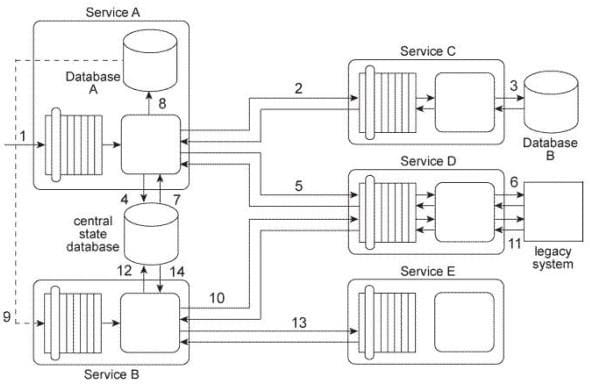
Upon reviewing these requirements it becomes evident to you that the Enterprise Service Bus compound
pattern will need to be applied. However, there are additional requirements that need to be fulfilled. To build this service composition architecture, which patterns that is not associated with the Enterprise Service Bus compound pattern need to also be applied? (Be sure to choose only those patterns that relate directly to the requirements described above. Patterns associated with the Enterprise Service Bus compound pattern include both the required or core patterns that are part of the basic compound pattern and the optional patterns that can extend the basic compound pattern.)
A. Atomic Service Transaction
B. Compensating Service Transaction
C. Data Format Transformation
D. Data Model Transformation
E. Event-Driven Messaging
F. Intermediate Routing
G. Policy Centralization
H. Process Centralization
I. Protocol Bridging
J. Redundant Implementation
K. Reliable Messaging
L. Service Data Replication
M. State Repository
-
Question 3:
You are an architect with a project team building services for Service Inventory A . You are told that no SLAs for Service B and Service C are available. You cannot determine how available these services will be, but it has been confirmed that both of these services support atomic transactions and the issuance of positive and negative acknowledgements. However, you also find out that the services in Service Inventory B use different data models than the services in Service Inventory A. Furthermore, recent testing results have shown that the performance of Service D is steady and reliable. However, Service D uses a different transport protocol than the services in Service Inventory A. The response time of Service A is not a primary concern, but Service Consumer A does need to be able to issue request messages to Service A 24 hours a day without disruption. What steps can be taken to fulfill these requirements?
A. The Event-Driven Messaging pattern is applied so that a subscriber-publisher relationship is established between Service Consumer A and Service A . This gives Service A the flexibility to provide its response to Service Consumer A whenever it is able to collect the three data values without having to require that Service Consumer A remain stateful. The Asynchronous Queuing pattern is applied so that a central messaging queue is positioned between Service A and Service B and between Service A and Service C . The Data Model Transformation and Protocol Bridging patterns are applied to enable communication between Service A and Service B and between Service A and Service C . The Service Autonomy principle is further applied to Service A in order to improve its overall runtime behavioral predictability.
B. The Reliable Messaging pattern is applied so that a system of acknowledgements is established between Service Consumer A and Service A . This gives Service A the flexibility to provide Service Consumer A with acknowledgements that indicate that the processing steps that are occurring between Service A and Service B, Service C, and Service D are progressing. The Asynchronous Queuing pattern is applied so that a central messaging queue is positioned between Service A and Service B and between Service A and Service C and between Service A and Service D . The Redundant Implementation pattern is applied so that a copy of Service D is brought in-Upon reviewing these requirements it becomes D with a standardized service contract that is in compliance with the design standards used in Service Inventory A.
C. The Asynchronous Queuing pattern is applied so that a central messaging queue is positioned between Service A and Service B and between Service A and Service C and between Service A and Service D and so that a separate messaging queue is positioned between Service A and Service Consumer A. The Data Model Transformation pattern is applied to enable communication between Service A and Service B and between Service A and Service C . The Protocol Bridging pattern is applied to enable communication between Service A and Service D .
D. None of the above.
-
Question 4:
Service Consumer A invokes Service A (1). The logic within Service A is required to retrieve three independent data values from Services B, C, and D and to then return these data values back to Service Consumer A.
To accomplish this, Service A begins by sending a request message to Service B (2). After receiving a response message with the first data value from Service B, Service A sends a request message to Service C (3). After it receives a response message with the second data value from Service C, Service A then sends a request message to Service D (4). Upon receiving a response message with the third data value from Service D. Service A finally sends its own response message (containing all three collected data values) back to Service Consumer A.
Service Consumer A and Service A reside in Service Inventory A. Service B and Service C reside in Service Inventory B. Service D is a public service that can be openly accessed via the World Wide Web. The service is also available for purchase so that it can be deployed independently within IT enterprises.
Due to the rigorous application of the Service Abstraction principle within Service Inventory B, the only information that is made available about Service B and Service C are the published service contracts. For Service D, the service contract plus a Service Level Agreement (SLA) are made available. The SLA indicates that Service D has a planned outage every night from 11 PM to midnight.
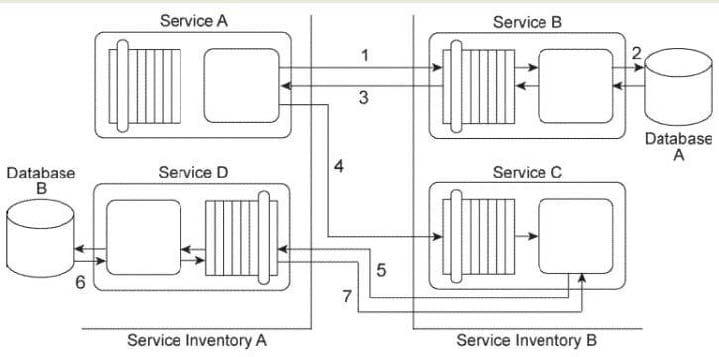
You are an architect with a project team building services for Service Inventory A . You are told that the owners of Service Inventory A and Service Inventory B are not generally cooperative or communicative. Cross-inventory service composition is tolerated, but not directly supported. As a result, no SLAs for Service B and Service C are available and you have no knowledge about how available these services are. Based on the service contracts you can determine that the services in Service Inventory B use different data models and a different transport protocol than the services in Service Inventory A. Furthermore, recent testing results have shown that the performance of Service D is highly unpredictable due to the heavy amount of concurrent access it receives from service consumers from other organizations. You are also told that there is a concern about how long Service Consumer A will need to remain stateful while waiting for a response from Service A . What steps can be taken to solve these problems?
A. The Event-Driven Messaging pattern is applied so that a subscriber-publisher relationship is established between Service Consumer A and Service A . This gives Service A the flexibility to provide its response to Service Consumer A whenever it is able to collect the three data values without having to require that Service Consumer A remain stateful. The Asynchronous Queuing pattern is applied so that a central messaging queue is positioned between Service A and Service B and between Service A and Service C . The Data Model Transformation and Protocol Bridging patterns are applied to enable communication between Service A and Service B and between Service A and Service C . The Redundant Implementation pattern is applied so that a copy of Service D is brought in- house and made part of Service Inventory A.
B. The Asynchronous Queuing pattern is applied so that a central messaging queue is positioned between Service A and Service B and between Service A and Service C and so that a separate messaging queue is positioned between Service A and Service Consumer
C. The Data Model Transformation and Protocol Bridging patterns are applied to enable communication between Service A and Service B and between Service A and Service C . The Redundant Implementation pattern is applied so that a copy of Service D is brought in- house for fail-over purposes. The Legacy Wrapper pattern is further applied to wrap Service D with a standardized service contract that is in compliance with the design standards used in Service Inventory
A. This wrapper utility service first attempts to access the external service, but if that service is
unavailable it will access the redundant internal service instead.
D. The Reliable Messaging pattern is applied so that a system of acknowledgements is established between Service Consumer A and Service A . This gives Service A the flexibility to provide Service Consumer A with acknowledgements that indicate that the processing steps that are occurring between Service A and Service B, Service C, and Service D are progressing. The Asynchronous Queuing pattern is applied so that a central messaging queue is positioned between Service A and Service B and between Service A and Service C and between Service A and Service D . The Data Model Transformation and Protocol Bridging patterns are applied to enable communication between Service A and Service B and between Service A and Service C .
E. None of the above.
-
Question 5:
Service Consumer A sends a message with a business document to Service A (1), which writes the business document to Database A (2). Service A then forwards the business document to Service B (3), which writes the business document to Database B (4).
Service B then responds to Service A with a message containing a failure or success code (5) after which Service A responds to Service Consumer A with a message containing a failure or success code (6). Upon receiving the message, Service Consumer A updates a log table in Database B (7). The log entry is comprised of the entire business document.
Database A is dedicated to the Service A service architecture and Database B is a shared database.
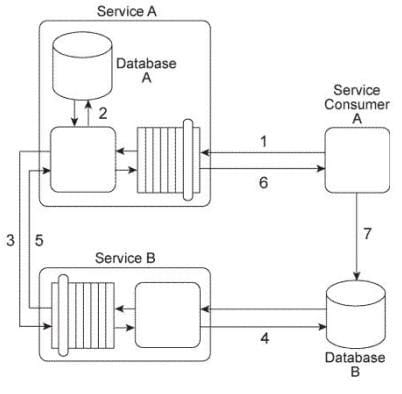
There are two problems with this service composition architecture that you are asked to address: First, both Service Consumer A and Service B need to transform the business document data from an XML format to a proprietary Comma Separated Value (CSV) in order to write the data to Database B. This has led to redundant data format transformation logic that has been difficult to keep in synch when Database B changes. Secondly, Service A is an entity service that is being reused by several other service compositions. It has lately developed reliability problems that have caused the service to become unavailable for extended periods. What steps can be taken to solve these problems?
A. The Legacy Wrapper pattern can be applied so that data access to Database B is separated into a new wrapper utility service. This way, the Data Format Transformation pattern only needs to be applied within the logic of this new service which will expose a standardized contract that both Service Consumer A and Service B can access. The Asynchronous Queuing pattern can be applied so that messaging queues are established between Service Consumer A and Service A and between Service A and Service B . The Service Autonomy principle can be further applied to Service A in order to establish a more isolated and reliable surrounding infrastructure.
B. The Legacy Wrapper pattern can be applied so that data access to Database B is separated into a new wrapper utility service. This way, the Data Format Transformation pattern only needs to be applied within the logic of this new service which will expose a standardized contract that both Service Consumer A and Service B can access. The Reliable Messaging pattern can be applied so that acknowledgements are passed between Service Consumer A and Service A and between Service A and Service B . The Service Composability principle can be further applied to Service A in order to optimize its service architecture for improved participation in multiple service compositions.
C. The service composition can be redesigned with the application of the Contract Centralization pattern so that instead of writing the business document to Database B, Service Consumer A sends the business document to Service B instead. This way, Service B would provide the only location where data format transformation logic for Database B needs to be carried out, which further supports the application of the Service Reusability principle. The Reliable Messaging pattern can be applied so that acknowledgements are passed between Service Consumer A and Service A and between Service A and Service B . The Service Composability principle can be further applied to Service A in order to optimize its service architecture for improved participation in multiple service compositions.
D. None of the above.
-
Question 6:
Service Consumer A sends a message with a business document to Service A (1), which writes the business document to Database A (2). Service A then forwards the business document to Service B (3), which writes the business document to Database B (4).
Service B then responds to Service A with a message containing a failure or success code (5) after which Service A responds to Service Consumer A with a message containing a failure or success code (6). Upon receiving the message, Service Consumer A updates a log table in Database B (7). The log entry is comprised of the entire business document. Database A is dedicated to the Service A service architecture and Database B is a shared database.
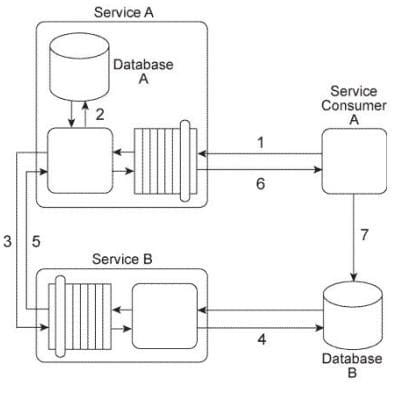
You are told that the database updates performed by Service A and Service B must be either both successful or they cannot happen at all. The database update performed by Service Consumer A must happen after it is given the outcome of the database updates performed by Service A and Service B . Given that Service Consumer A must also update Database B as part of this service composition architecture, how is it possible to fulfill these requirements?
A. The State Repository pattern can be applied so that Service A writes the business document data to a separate state database until it receives a response message from Service B . If the response message contains a success code, Service A writes the business document to Database A. If the response contains a failure code, Service A discards the data that was written to the state database.
B. The Service Data Replication pattern can be applied to Service Consumer A and Service B so that separate dedicated databases can be established allowing Service Consumer A to make updates independently of Service B . Service A is simply redesigned to not write the business document to Database A until after it receives a message containing a success code from Service B.
C. The Atomic Service Transaction pattern can be applied to encompass Service A, Service B and Service Consumer A. This will guarantee that all of the actions performed by the service composition participants will either be successful or will be rolled back if anyone is not successful.
D. None of the above.
-
Question 7:
Service Consumer A sends Service A a message containing a business document (1). The business document is received by Component A, which keeps the business document in memory and forwards a copy to Component B (3). Component B first writes portions of the business document to Database A (4).
Component B writes the entire business document to Database B and then uses some of the data values from the business document as query parameters to retrieve new data from Database B (5).
Next, Component B returns the new data back to Component A (6), which merges it together with the original business document it has been keeping in memory and then writes the combined data to Database C (7). The Service A service capability invoked by Service Consumer A requires a synchronous request-response data exchange. Therefore, based on the outcome of the last database update, Service A returns a message with a success or failure code back to Service Consumer A (8).
Databases A and B are shared and Database C is dedicated to the Service A service architecture.
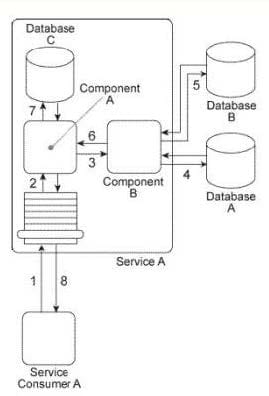
There are several problems with this architecture: The business document that Component A is required to keep in memory (while it waits for Component B to complete its processing) can be very large. Especially when Service A is concurrently invoked by multiple service consumers, the amount of runtime resources it uses to keep this data in memory can decrease the overall performance of all service instances. Additionally, because Database A is a shared database that sometimes takes a long time to respond to Component B, Service A can take a long time to respond back to Service Consumer A . Currently, Service Consumer A will wait for a response for up to 30 seconds after which it will assume the request to Service A has failed and any subsequent response messages from Service A will be rejected. What steps can be taken to solve these problems?
A. The Service Statelessness principle can be applied together with the State Repository pattern in order to extend Database C so that it also becomes a state database allowing Component A to temporarily defer the business document data while it waits for a response from Component B. The Service Autonomy principle is applied together with the Legacy Wrapper pattern to isolate Database A so that it is encapsulated by a separate wrapper utility service. The Compensating Service Transaction pattern is applied so that if the response time of Service A exceeds 30 seconds, a notification is sent to a human administrator to raise awareness of the fact that the eventual response of Service A will be rejected by Service Consumer A.
B. The Service Statelessness principle can be applied together with the State Repository pattern in order to establish a state database that Component A can defer the business document data to while it waits for a response from Component B. The Service Autonomy principle can be applied together with the Service Data Replication pattern to establish a dedicated replicated database for Component B to access instead of the shared Database
C. The Asynchronous Queuing pattern can be applied to establish a messaging queue between Service Consumer A and Service A so that Service Consumer A does not need to remain stateful while it waits for a response from Service A .
D. The Service Statelessness principle can be applied together with the State Repository pattern in order to establish a state database that Component A can defer the business document data to while it waits for a response from Component B. The Service Autonomy principle can be applied together with Service Abstraction principle, the Legacy Wrapper pattern, and the Service Facade pattern in order to isolate Database A so that it is encapsulated by a separate wrapper utility service and to hide the Database A implementation from Service A and to position a Facade component between Component B and the new wrapper service. This Facade component will be responsible for compensating the unpredictable behavior of Database A.
E. None of the above.
-
Question 8:
Service Consumer A sends Service A a message containing a business document (1). The business document is received by Component A, which keeps the business document in memory and forwards a copy to Component B (3). Component B first writes portions of the business document to Database A (4).
Component B writes the entire business document to Database B and then uses some of the data values from the business document as query parameters to retrieve new data from Database B (5).
Next, Component B returns the new data back to Component A (6), which merges it together with the original business document it has been keeping in memory and then writes the combined data to Database C (7). The Service A service capability invoked by Service Consumer A requires a synchronous request-response data exchange. Therefore, based on the outcome of the last database update, Service A returns a message with a success or failure code back to Service Consumer A (8).
Databases A and B are shared and Database C is dedicated to the Service A service architecture.

There are several problems with this architecture: First, the response time of Database A is often poor, resulting in Component B taking too much time to provide a response to Component A. This results in Component A consuming too many runtime resources while it holds the business document in memory and it also causes unreasonable delays in responding to Service Consumer A. Additionally, Database B is being replaced with a different database product that supports a proprietary file format. This will disable the current interaction between Component B and the new Database B. What steps can be taken to solve these problems?
A. The State Repository pattern is applied so that Component A can defer the business document data to a state database while it waits for a response from Component B. The Service Data Replication pattern is applied so that Component B can interact with a database that is replicated from the shared Database A. This will improve performance and reliability that will affect both Component A and Service Consumer A. Finally, the Legacy Wrapper pattern is applied so that Database B is wrapped in a standardized contract. This will establish a new wrapper utility service that will allow Database B to be replaced with a different database product without affecting Service A . Furthermore, the Data Format
Transformation pattern can be applied within the new wrapper utility service to enable it to convert to
and from the new proprietary file format.
B. The State Repository pattern is applied so that Component A can defer the business document data to a state database while it waits for a response from Component B. The Asynchronous Queuing pattern can be applied so that a messaging queue is established between Service Consumer A and Service A, thereby guaranteeing delivery and avoiding Service Consumer A from being tied up too long waiting for Service A to respond. Finally, the Data Format Transformation pattern can be applied to enable Component B to convert to and from the new proprietary file format introduced by the database product that is replacing Database B.
C. The Legacy Wrapper pattern is applied so that Database B is wrapped in a standardized contract. This will establish a new wrapper utility service that will allow Database B to be replaced with a different database product without affecting Service A . The Data Format Transformation pattern can be applied within the new wrapper utility service to enable it to convert to and from the new proprietary file format. The Service Data Replication pattern is applied so that Component B can interact with a database that is replicated from the shared Database B, regardless of what database product is used to replace Database B. The Service Abstraction principle can be further applied to hide the implementation details, including the changes mentioned in this solution, from Service Consumer A.
D. None of the above.
-
Question 9:
When Service A receives a message from Service Consumer A(1),the message is processed by Component A. This component first invokes Component B (2), which uses values from the message to query Database A in order to retrieve additional data. Component B then returns the additional data to Component A.
Component A then invokes Component C (3), which interacts with the API of a legacy system to retrieve a new data value. Component C then returns the data value back to Component A.
Next, Component A sends some of the data it has accumulated to Component D (4), which writes the data to a te>X file that is placed in a specific folder. Component D then waits until this file is imported into a different system via a regularly scheduled batch import. Upon completion of the import, Component D returns a success or failure code back to Component A.
Component A finally sends a response to Service Consumer A (5) containing all of the data collected so far and Service Consumer A writes all of the data to Database B (6).
Components A, B, C. and D belong to the Service A service architecture. Database A, the legacy system, and the file folders are shared resources within the IT enterprise.
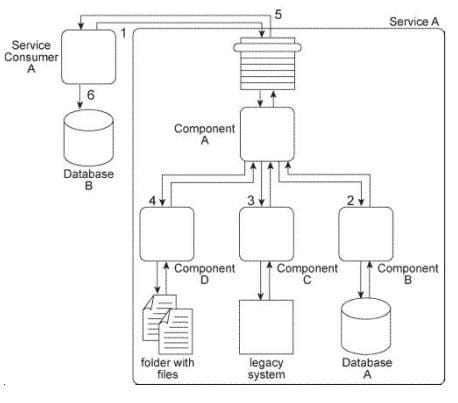
Service A is an entity service with a service architecture that has grown over the past few years. As a result of a service inventory-wide redesign project, you are asked to revisit the Service A service architecture in order to separate the logic provided by Components B, C, and D into three different utility services without disrupting the behavior of Service A as it relates to Service Consumer A . What steps can be taken to fulfill these requirements?
A. The Legacy Wrapper pattern can be applied so that Component B is separated into a separate wrapper utility service that wraps the shared database. The Asynchronous Queuing pattern can be applied so that a messaging queue is positioned between Component A and Component C, thereby enabling communication during times when the legacy system may be unavailable or heavily accessed by other parts of the IT enterprise. The Service Facade pattern can be applied so that a Facade component is added between Component A and Component D so that any change in behavior can be compensated. The Service Autonomy principle can be further applied to Service A to help make up for any performance loss that may result from splitting the component into a separate wrapper utility service.
B. The Legacy Wrapper pattern can be applied so that Component B is separated into a separate utility service that wraps the shared database. The Legacy Wrapper pattern can be applied again so that Component C is separated into a separate utility service that acts as a wrapper for the legacy system API. The Legacy Wrapper pattern can be applied once more to Component D so that it is separated into another utility service that provides standardized access to the file folder. The Service Facade pattern can be applied so that three Facade components are added: one between Component A and each of the new wrapper utility services. This way, the Facade components can compensate for any change in behavior that may occur as a result of the separation. The Service Composability principle can be further applied to Service A and the three new wrapper utility services so that all four services are optimized for participation in the new service composition. This will help make up for any performance loss that may result from splitting the three components into separate services.
C. The Legacy Wrapper pattern can be applied so that Component B is separated into a separate utility service that wraps the shared database. The Legacy Wrapper pattern can be applied again so that Component C is separated into a separate utility service that acts as a wrapper for the legacy system API. Component D is separated into a separate service and the Event-Driven Messaging pattern is applied to establish a publisher-subscriber relationship between this new service and Component A. The interaction between Service Consumer A and Component A is then redesigned so that Component A first interacts with Component B and the new wrapper service. Service A then issues a final message back to Service Consumer A. The Service Composability principle can be further applied to Service A and the three new wrapper utility services so that all four services are optimized for participation in the new service composition. This will help make up for any performance loss that may result from splitting
the three components into separate services.
D. None of the above.
-
Question 10:
When Service A receives a message from Service Consumer A(1),the message is processed by Component A. This component first invokes Component B (2), which uses values from the message to query Database A in order to retrieve additional data. Component B then returns the additional data to Component A.
Component A then invokes Component C (3), which interacts with the API of a legacy system to retrieve a new data value. Component C then returns the data value back to Component A.
Next, Component A sends some of the data it has accumulated to Component D (4), which writes the data to a text file that is placed in a specific folder. Component D then waits until this file is imported into a different system via a regularly scheduled batch import. Upon completion of the import, Component D returns a success or failure code back to Component A.
Component A finally sends a response to Service Consumer A (5) containing all of the data collected so far and Service Consumer A writes all of the data to Database B (6).
Components A, B, C. and D belong to the Service A service architecture. Database A, the legacy system, and the file folders are shared resources within the IT enterprise.
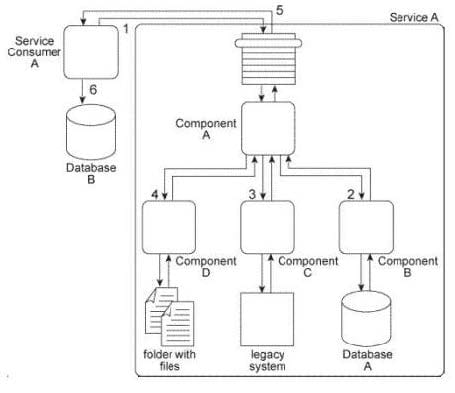
Service A is a task service that completes an entire business task on its own without having to compose other services. However, you have received many complaints about the reliability of Service A . Specifically, it has three problems. First, when Component B accesses Database A, it may not receive a response for several minutes when the database is being accessed by other applications in the IT enterprise. Secondly, the legacy system accessed by Component C frequently crashes and therefore becomes unavailable for extended periods of time. Third, for Component D to respond to Component A, it must first wait for the batch import of the files to occur. This can take several minutes during which Service Consumer A remains stateful and consumes excessive memory. What steps can be taken to address these three problems?
A. The Legacy Wrapper pattern can be applied so that Component B is separated to wrap the shared database, thereby allowing Component A to interact with this new service instead of directly interacting with the database. The Legacy Wrapper pattern can be applied again so that Component C is separated into a separate service that acts as a wrapper of the legacy system API. Component D can then be separated into a separate service and the Event-Driven Messaging pattern can be applied to establish a publisher- subscriber relationship between this new service and Component A and between Service A and Service Consumer A. The interaction between Service Consumer A and Component A is then redesigned so that Component A issues a message back to Service Consumer A when the event related to the batch import is triggered.
B. The Service Data Replication pattern can be applied so that Component B can access a replicated database instead of having to access the shared Database A directly. The Legacy Wrapper pattern can be applied so that Component C is separated into a separate service that acts as a wrapper of the legacy system API. Next, the Reliable Messaging pattern can be applied so that acknowledgements are issued from the new wrapper service to Component A, thereby enabling notifying Component A during times when the legacy system is unavailable. Finally, Component D is separated into a separate service and the Event-Driven Messaging pattern is applied to establish a publisher-subscriber relationship between this new service and Component A. The interaction between Service Consumer A and Component A is then redesigned so that Component A first interacts with Component B and the new wrapper service. Service A then issues a final message back to Service Consumer A.
C. The Service Data Replication pattern can be applied so that Component B can access a replicated database instead of having to access the shared Database A directly. The Legacy Wrapper pattern can be applied so that Component C is separated into a separate service that acts as a wrapper of the legacy system API. Next, the Asynchronous Queuing pattern can be applied so that a messaging queue is positioned between Component A and the new wrapper service, thereby enabling communication during times when the legacy system is unavailable. Finally, Component D is separated into a new service and the Event-Driven Messaging pattern is applied to establish a publisher-subscriber relationship between this service and Component A and between Service A and Service Consumer A. The interaction logic is redesigned as follows: Component A interacts with Component B, the new wrapper service, and then issues a request to the new event-driven service. Upon receiving a response triggered by the event related to the batch import, Service A responds to Service Consumer A.
D. None of the above.
Related Exams:
S90-01A
Fundamental SOA & Service-Oriented Computing (S90-01A)S90-02A
SOA Technology Concepts (S90-02A)S90-03A
SOA Design & Architecture (S90-03A)S90-08A
Advanced SOA Design & Architecture (S90-08A)S90-09A
SOA Design & Architecture Lab (S90-09A)S90.08B
SOA Design & Architecture Lab with Services & Microservices
Tips on How to Prepare for the Exams
Nowadays, the certification exams become more and more important and required by more and more enterprises when applying for a job. But how to prepare for the exam effectively? How to prepare for the exam in a short time with less efforts? How to get a ideal result and how to find the most reliable resources? Here on Vcedump.com, you will find all the answers. Vcedump.com provide not only SOA exam questions, answers and explanations but also complete assistance on your exam preparation and certification application. If you are confused on your S90.09 exam preparations and SOA certification application, do not hesitate to visit our Vcedump.com to find your solutions here.